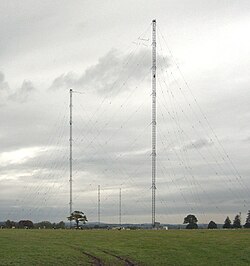Droitwich transmitting station

Masts at the Droitwich transmitting station
|
|
| Location | Droitwich, Worcestershire |
|---|---|
| Mast height | 213.36 metres (700 ft) |
| Coordinates | 52°17′48″N 2°06′19″W / 52.296666666667°N 2.1052777777778°WCoordinates: 52°17′48″N 2°06′19″W / 52.296666666667°N 2.1052777777778°W |
| Grid reference | SO929663 |
| Built | 1934 |
The Droitwich transmitting station is a large broadcasting facility for long-wave and medium-wave transmissions, established in 1934 in the civil parish of Dodderhill, just outside the village of Wychbold, near Droitwich in Worcestershire, England (grid reference SO929663). The site is the location of the British Broadcasting Corporation's most powerful long-wave transmitter, which together with the two Scottish long-wave transmitters at Burghead and Westerglen forms a network broadcasting on the same frequency. The masts can be seen to the east from the M5 motorway, between Droitwich and Bromsgrove. At night, the two sets of aircraft warning lights are visible from a long distance. The station is owned and operated by Arqiva.
The long-wave frequency used was 200 kilohertz until 1 February 1988 when it was changed to 198 kilohertz, and the power is currently 500 kilowatts. The carrier frequency is controlled by a rubidium atomic frequency standard in the transmitter building, enabling the transmission to be used as an off-air frequency standard. For long-wave, a T-aerial is used, which is suspended between two 213-metre-high (700 ft) guyed steel lattice radio masts, which stand 180 metres (590 ft) apart from each other. There are also two guyed mast radiators at the site, which are used for transmitting AM medium-wave radio programmes on 693 kilohertz, 1053 kilohertz and 1215 kilohertz.
...
Wikipedia

